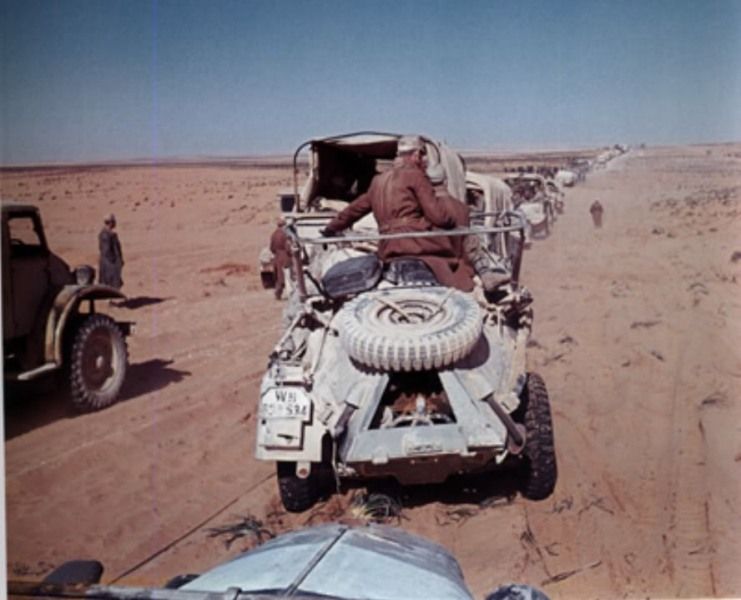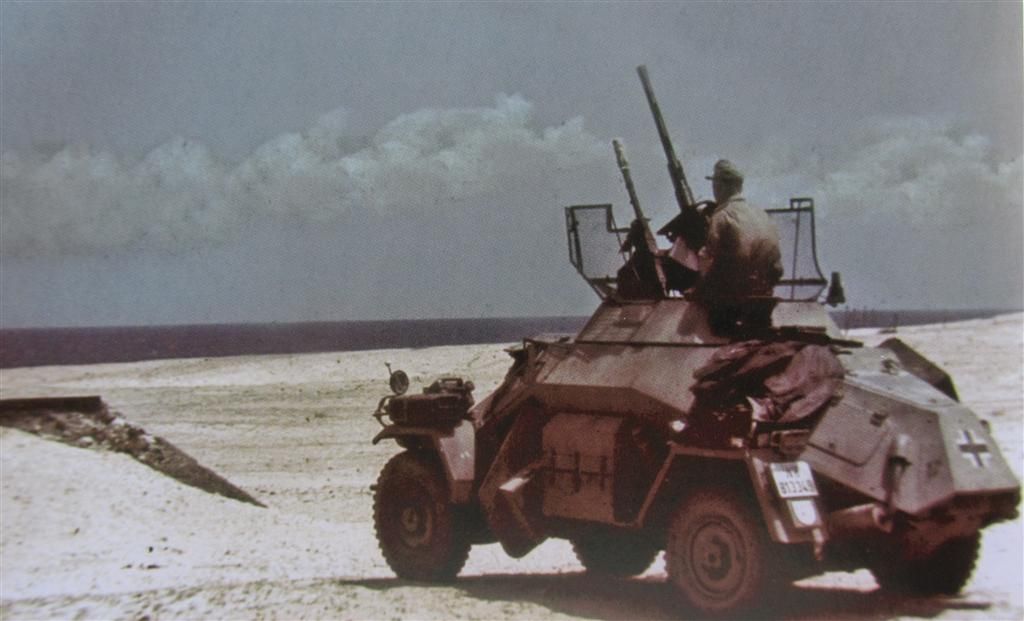Hi guys,
I would like to know what was the german doctrine regarding exhausts during WWII. Did they paint them black, the base color of the vehicle or any other color?
Thanks in advance,
Angel
Hosted by Darren Baker
WWII German exhaust painting doctrine
Anmoga

Joined: November 18, 2004
KitMaker: 456 posts
Armorama: 333 posts

Posted: Wednesday, September 07, 2016 - 08:27 PM UTC

GeraldOwens

Joined: March 30, 2006
KitMaker: 3,736 posts
Armorama: 3,697 posts

Posted: Wednesday, September 07, 2016 - 09:22 PM UTC
They were painted the base color, but engine heat soon blistered the paint off, and they would rust quickly.
Anmoga

Joined: November 18, 2004
KitMaker: 456 posts
Armorama: 333 posts

Posted: Wednesday, September 07, 2016 - 09:50 PM UTC
Hi Gerald,
Thanks for your help.
I simply wanted to know since they used a different primer for gun barrels and wanted to know if they did something similar with exhausts and maybe they left them in the primer as they did sometimes with gun barrels.
In the following photo of an Afrika Korps Sd.Kfz. 222 painted in Dark Grey and completely covered by dust I am not sure if the tube of the exhaust is black or a very dark brown and curiously is not covered by dust.

In the next photo another Afrika Korps Sd.Kfz. 222 seems to be painted in the troppen scheme and the exhausts seem to have been painted over with the troppen scheme although the tube seems not to be painted or have lost all the paint (which looks odd that they didn't paint only the tube or that only the tube lost the paint).

Best regards,
Angel
Thanks for your help.
I simply wanted to know since they used a different primer for gun barrels and wanted to know if they did something similar with exhausts and maybe they left them in the primer as they did sometimes with gun barrels.
In the following photo of an Afrika Korps Sd.Kfz. 222 painted in Dark Grey and completely covered by dust I am not sure if the tube of the exhaust is black or a very dark brown and curiously is not covered by dust.

In the next photo another Afrika Korps Sd.Kfz. 222 seems to be painted in the troppen scheme and the exhausts seem to have been painted over with the troppen scheme although the tube seems not to be painted or have lost all the paint (which looks odd that they didn't paint only the tube or that only the tube lost the paint).

Best regards,
Angel

GeraldOwens

Joined: March 30, 2006
KitMaker: 3,736 posts
Armorama: 3,697 posts

Posted: Wednesday, September 07, 2016 - 11:36 PM UTC
I assumed you were asking about tanks--my mistake. Tank engines run very hot, and rust occurs almost immediately.
Exhausts on cars and trucks would exhibit rust over time, as on civilian vehicles, but I am not aware of any special policies regarding painting them, or any use of high temperature primers. As far as I know, entire vehicles received the same base coat of paint.
Exhausts on cars and trucks would exhibit rust over time, as on civilian vehicles, but I am not aware of any special policies regarding painting them, or any use of high temperature primers. As far as I know, entire vehicles received the same base coat of paint.
Posted: Thursday, September 08, 2016 - 04:00 AM UTC
Thanks for bringing this up Angel, as I'm also curious about this. Gerald, would you say that the rusting on the exhaust be the same regardless if the tank was operating in either desert or temperate / cold climate? Cheers, Tat
Anmoga

Joined: November 18, 2004
KitMaker: 456 posts
Armorama: 333 posts

Posted: Thursday, September 08, 2016 - 04:40 PM UTC
Thanks Gerald for your help,
Angel
Angel
alanmac

Joined: February 25, 2007
KitMaker: 3,033 posts
Armorama: 2,953 posts

Posted: Thursday, September 08, 2016 - 05:07 PM UTC
The exhaust downpipe leading from the engine to the exhaust would get very hot and as such unlikely to retain paint for any length of time.
We are talking about exhaust systems made over seventy years ago when such concerns as emissions, noise levels etc. were not considered with the importance it is today. Neither would the visual appearance of this be an issue on a military vehicle such as a tank or armoured vehicle as opposed to private cars etc.
Constructed of plain steel these, once stripped of their paint with heat, would soon show signs of rust on the exposed bare metal. Depending on the amount of time the rusting had started to coat the bare metal the colour would vary from a bright orange in the early stages to a dark brown.
We are talking about exhaust systems made over seventy years ago when such concerns as emissions, noise levels etc. were not considered with the importance it is today. Neither would the visual appearance of this be an issue on a military vehicle such as a tank or armoured vehicle as opposed to private cars etc.
Constructed of plain steel these, once stripped of their paint with heat, would soon show signs of rust on the exposed bare metal. Depending on the amount of time the rusting had started to coat the bare metal the colour would vary from a bright orange in the early stages to a dark brown.
Anmoga

Joined: November 18, 2004
KitMaker: 456 posts
Armorama: 333 posts

Posted: Thursday, September 08, 2016 - 05:35 PM UTC
Thanks Alan for the information,
Angel
Angel
brekinapez

Joined: July 26, 2013
KitMaker: 2,272 posts
Armorama: 1,860 posts

Posted: Thursday, September 08, 2016 - 05:51 PM UTC
Quoted Text
Thanks for bringing this up Angel, as I'm also curious about this. Gerald, would you say that the rusting on the exhaust be the same regardless if the tank was operating in either desert or temperate / cold climate? Cheers, Tat
A lot of it would depend on humidity levels and such; rust develops at different rates based on the conditions the metal is exposed to.
Posted: Thursday, September 08, 2016 - 06:54 PM UTC
Thanks Alan, Shell! 


GeraldOwens

Joined: March 30, 2006
KitMaker: 3,736 posts
Armorama: 3,697 posts

Posted: Friday, September 09, 2016 - 05:59 AM UTC
Quoted Text
Thanks for bringing this up Angel, as I'm also curious about this. Gerald, would you say that the rusting on the exhaust be the same regardless if the tank was operating in either desert or temperate / cold climate? Cheers, Tat
The humidity would be irrelevant in this case, as the application of intense heat to bare steel exposed to oxygen speeds up the oxidation process. Tank exhausts ran red hot, and the paint would disappear immediately. On postwar British Comet tanks, the paint would blister off the two fantail exhaust pipes every time they ran the engine, and the Regimental Sergeant Major would require the pipes to be repainted with silver paint every single time--daily, if necessary. The British Army does treasure futility.
Bravo1102

Joined: December 08, 2003
KitMaker: 2,864 posts
Armorama: 2,497 posts

Posted: Friday, September 09, 2016 - 07:26 AM UTC
Scurry under your car sometime. Your exhaust pipes through a mix of oxidization and soot appear a deep brown to black.
The soot from running the engine can and will cover the rust every time the engine is running. Also pipes on a running engine can bake off the rust and just be a heated blue-grey-black metal. Like the spoon I use to stir my tea every morning is blue black from being in the boiling water everyday.
The soot from running the engine can and will cover the rust every time the engine is running. Also pipes on a running engine can bake off the rust and just be a heated blue-grey-black metal. Like the spoon I use to stir my tea every morning is blue black from being in the boiling water everyday.
Anmoga

Joined: November 18, 2004
KitMaker: 456 posts
Armorama: 333 posts

Posted: Friday, September 09, 2016 - 07:44 PM UTC
Thanks Shell, Gerald and Stephen.
I have taken a look under my parents cars but I don't trust what I see as a valid reference since the materials used and the manufacturing procedures have changed a lot. I even have taken photos
Best regards,
Angel
I have taken a look under my parents cars but I don't trust what I see as a valid reference since the materials used and the manufacturing procedures have changed a lot. I even have taken photos
Best regards,
Angel
Posted: Saturday, September 10, 2016 - 03:54 AM UTC
Quoted Text
Quoted TextThanks for bringing this up Angel, as I'm also curious about this. Gerald, would you say that the rusting on the exhaust be the same regardless if the tank was operating in either desert or temperate / cold climate? Cheers, Tat
The humidity would be irrelevant in this case, as the application of intense heat to bare steel exposed to oxygen speeds up the oxidation process. Tank exhausts ran red hot, and the paint would disappear immediately. On postwar British Comet tanks, the paint would blister off the two fantail exhaust pipes every time they ran the engine, and the Regimental Sergeant Major would require the pipes to be repainted with silver paint every single time--daily, if necessary. The British Army does treasure futility.
Thanks Gerald, Stephen. I vaguely recall reading somewhere that DAK vehicles don't rust as much, reason for the question. Good to know how the colors transition. I personally am not a fan of exhausts that are very much on the orange side so I typically do mine more towards a darker brown with just hint of orange or red

Removed by original poster on 09/13/16 - 00:24:11 (GMT).
 |










